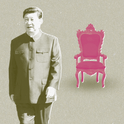Among my numerous conversations with Chinese friends during my first months in America in 2005, one has lingered with me. “I realised today,” said a high school friend who was just starting his freshman year at Duke University, “that the word ‘cheese’ is essentially useless. Here, people call each kind of cheese by its name, and I don’t know any of them.”
At the time, the complaint felt like an apt encapsulation of my own struggles as a Chinese newcomer in a New England private school, where everything from the fast-paced seminar discussions to the ritualistic Sunday dinners seemed to entail an unfamiliar set of languages and manners. Back in China, my friend and I had learned to solve tricky algebra questions and memorised esoteric English vocabulary. But here, we couldn’t call cheese by its name.
Neither did the taste of cheese, with its tangy flavour and muttony punch, agree with my palate. Cheese is not part of the Chinese culinary tradition, except among ethnic minorities like the Mongols and Tibetans, who live near the country’s borders. (A high proportion of Chinese are lactose intolerant, but this does not prevent them from eating cheese, as the fermentation process removes most of the lactose.)
By the time I came back to China in 2012 after graduating from Yale, my tastes had changed. My college town, New Haven, serves what many regard as America’s best thin-crust pizza, which instilled in me a frequent craving for fresh and steaming mozzarella. During my year-long post-graduation internship at a Washington DC-based magazine, a colleague, a New Yorker with a penchant for Woody Allen movies and fine cheese, took me to an organic food market and pointed out brie, parmesan and gorgonzola. The names alone enlivened my taste buds.
In my final months in America, I was bracing myself for my return to Beijing, which, despite its familiar comforts, lacked the alluring pungency I had become accustomed to on western dinner tables.
I was thrilled to find out that I was wrong. China, with a booming middle class and a growing appetite for western indulgences, is now targeted by foreigners and locals alike who hope to transform what was once deemed a substance for the nomadic barbarians into a symbol of cultivated taste.
Expatriates host cheese-tasting events in Beijing and Shanghai, regaling visitors with the history and culture behind each product. Popular retail websites promote wine and cheese packages with names such as “A Cheesy Night in Paris” and “A Feast of Cheesy Love,” with prices ranging from £25 to £110.
The trend is also being driven by young, hip Chinese like Liu Yang, the owner of Le Fromager de Pekin, a Beijing-based artisanal cheese shop, who wants to “expose Chinese palates to the authentic taste of French artisan cheese,” as he puts it on his company website.
The market for cheese is indeed growing, albeit from a low base. In February this year, China imported 5,091 tons of cheese, a 111 per cent year-on-year increase, according to the Dairy Association of China. The overall cheese consumption has been increasing at an annual rate of 20 per cent in recent years, foreign sellers estimate. The growth is to a large extent driven by the demand for mass-produced processed cheese like cheddar and mozzarella, used as ingredients in fast food chains like Pizza Hut and McDonald’s. Unlike coffee and red wine, however, European-style “old world” cheese has yet to enter the mainstream in China.
Liu’s shop sells over 100kg of cheese per week, two thirds of it to expatriates. He describes his limited numbers of local customers as mostly young parents who value cheese as a source of nutrition for their children, or people who treat it as an accompaniment to wine. Few enjoy it purely for its taste.
The fundamental problem, Liu believes, lies in cheese’s “lack of cultural roots in China.” Red wine may appeal to the Chinese, given the country’s long history of alcohol consumption and its obsession with the health implications of foods. Loving cheese, on the other hand, would mean having to embrace it for its difference, as well as the culture associated with it. This has proved difficult. At the moment, Liu says, promoting cheese to a Chinese market still requires “striking a fine balance between maintaining its western image and giving it a Chinese twist,” for example by incorporating it into Chinese recipes.
Just like my own conversion to being a cheese devotee, China’s acceptance of cheese needs to take place organically, driven by open-mindedness and deepening cultural understanding. While individuals like Liu are encouraging that process, larger forces are also at work.
In May, China slapped a ban on all cheese imports from Britain, after Chinese officials conducted a spot check at a British dairy and were unsatisfied with its hygiene standards.
Chinese consumers could not help but point out the irony: misgivings over the quality of milk products run high at home, after a scandal in 2008 when it emerged that tainted infant formula had killed six babies and left 300,000 sick across the country. So many Chinese tourists in London are carting infant formula home that big retailers like Boots and Sainsbury’s have declared a two-can limit per customer. “Did the UK dairy forget to bribe the inspectors?” one web user asked sarcastically on Weibo, China’s popular social media platform.
In early June, the ban was quietly lifted, though most Chinese have remained unaware of the controversy. On a recent afternoon, Chinese shoppers at a western food market in Beijing were scant. A few who stopped by the cheese counter, however, took their time deliberating between slices of brie and parmesan. One mother told me she was not buying it out of personal preference. “I’m too old to get used to the taste of this,” she smiled, and looked at her seven-year-old daughter. “But I hope she will like it, or at least learn to, because one day she will go abroad.”












